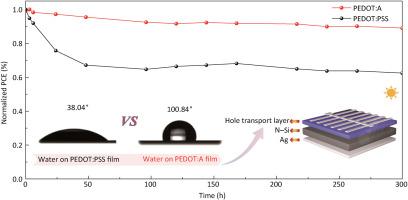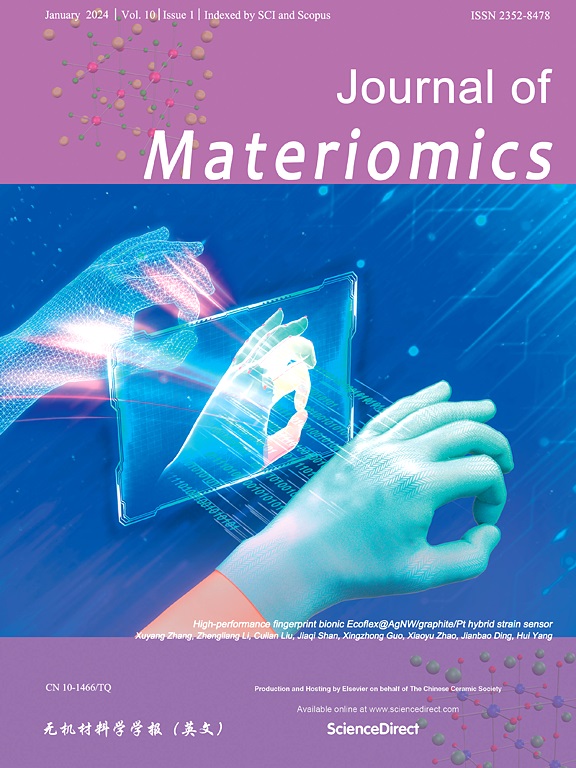Air-stable silicon hybrid solar cells constructed via hydrophobic polymer film
IF 8.4
1区 材料科学
Q1 CHEMISTRY, PHYSICAL
引用次数: 0
Abstract
Silicon (Si) hybrid solar cells have advantages of solution manufacturing process and the potential for achieving low-cost fabrication compared to crystalline Si solar cells. However, the functional layer prepared by solution method usually absorbs water molecules from the air, posing a challenge to the stability of the device. Here, a PEDOT derivative, PEDOT:A, was in situ prepared through the introduction of a fluoropolymer, yielding a strongly hydrophobic film that was assembled into a PEDOT:A/Si hybrid solar cell. The PEDOT:A/Si hybrid solar cells retained 90% of its initial performance after storage in the air for 300 h, while PEDOT:PSS only retained 60% with identical device structure. Meanwhile, first principles calculations indicate that the binding energy between fluoropolymer and water molecule was 3.48 kJ/mol, whereas the binding energy between PSS and water molecule was −5.76 kJ/mol. Benefiting from the weak interaction between fluoropolymer and water molecule, the contact angle of water on PEDOT:A film was 100.84°. After optimization, PEDOT:A/Si hybrid solar cells with ITO achieved a power conversion efficiency of 6.43%, retained 97% of its initial efficiency after testing under same conditions. The development of air-stable hybrid device technology is promising in opening up practical applications of low-cost Si based solar cells.

通过疏水性聚合物薄膜构建空气稳定硅混合太阳能电池
与晶体硅太阳能电池相比,硅(Si)混合太阳能电池具有溶液制造工艺的优势和实现低成本制造的潜力。然而,用溶液法制备的功能层通常会吸收空气中的水分子,给器件的稳定性带来挑战。在这里,通过引入含氟聚合物原位制备了一种 PEDOT 衍生物 PEDOT:A,生成了一种强疏水性薄膜,并将其组装到 PEDOT:A/Si 混合太阳能电池中。PEDOT:A/Si混合太阳能电池在空气中储存300小时后,其初始性能保持了90%,而器件结构相同的PEDOT:PSS仅保持了60%。同时,第一性原理计算表明,氟聚合物与水分子的结合能为 3.48 kJ/mol,而 PSS 与水分子的结合能为 -5.76 kJ/mol。得益于氟聚合物与水分子之间的微弱相互作用,水在 PEDOT:A 薄膜上的接触角为 100.84°。经过优化,PEDOT:A/Si 与 ITO 混合太阳能电池的功率转换效率达到了 6.43%,在相同条件下测试后仍保持了 97% 的初始效率。空气稳定混合器件技术的开发有望开拓低成本硅基太阳能电池的实际应用。
本文章由计算机程序翻译,如有差异,请以英文原文为准。
求助全文
约1分钟内获得全文
求助全文
来源期刊

Journal of Materiomics
Materials Science-Metals and Alloys
CiteScore
14.30
自引率
6.40%
发文量
331
审稿时长
37 days
期刊介绍:
The Journal of Materiomics is a peer-reviewed open-access journal that aims to serve as a forum for the continuous dissemination of research within the field of materials science. It particularly emphasizes systematic studies on the relationships between composition, processing, structure, property, and performance of advanced materials. The journal is supported by the Chinese Ceramic Society and is indexed in SCIE and Scopus. It is commonly referred to as J Materiomics.
 求助内容:
求助内容: 应助结果提醒方式:
应助结果提醒方式:


